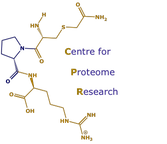Methodology for hunting histidine phosphorylation
Gemma Hardman and Claire E. Eyers (2020) High-Throughput Characterization of Histidine Phosphorylation Sites Using UPAX and Tandem Mass Spectrometry. Methods in Molecular Biology 2020;2077:225-235.
Liquid chromatography (LC)-tandem mass spectrometry (MS/MS) is key for the characterization of phosphorylation sites in a high-throughput manner, and its application has proven essential to elucidate the phosphoproteome of many biological systems. Following proteolytic digestion of proteins extracted from tissues or cells, phosphopeptides are typically enriched by affinity chromatography using TiO2 or metal-ions (e.g., Fe3+) coupled to solid-phase materials, prior to LC-MS/MS analysis. Separation of relatively low abundance phosphopeptides from nonphosphorylated peptides in these types of extremely complex mixtures is essential to maximize coverage of the phosphoproteome. Maintaining acidic conditions during these IMAC or TiO2-based enrichment minimizes the concurrent unwanted binding of highly acidic peptides. However, while peptides containing phosphomonoesters, namely, phosphoserine (pSer), phosphothreonine (pThr), and phosphotyrosine (pTyr), are stable under these acidic binding conditions, phosphopeptides containing acid-labile phosphate group such as phosphohistidine (pHis), are not. Conse- quently, hydrolysis of these types of phosphopeptides occurs during standard phosphopeptide enrichment, and subsequent phosphosite identification by LC-MS/MS is severely compromised. Here we describe UPAX, unbiased phosphopeptide enrichment using strong anion exchange, for the separation of both acid- stable (pSer, pThr, pTyr) and acid-labile phosphopeptides (including those containing pHis) from nonpho- sphorylated peptides. We outline how implementation of UPAX prior to a minimally modified standard proteomics workflow can be used to identify sites of pHis as well as other acid-labile, as well as acid-stable phosphosites.
Liquid chromatography (LC)-tandem mass spectrometry (MS/MS) is key for the characterization of phosphorylation sites in a high-throughput manner, and its application has proven essential to elucidate the phosphoproteome of many biological systems. Following proteolytic digestion of proteins extracted from tissues or cells, phosphopeptides are typically enriched by affinity chromatography using TiO2 or metal-ions (e.g., Fe3+) coupled to solid-phase materials, prior to LC-MS/MS analysis. Separation of relatively low abundance phosphopeptides from nonphosphorylated peptides in these types of extremely complex mixtures is essential to maximize coverage of the phosphoproteome. Maintaining acidic conditions during these IMAC or TiO2-based enrichment minimizes the concurrent unwanted binding of highly acidic peptides. However, while peptides containing phosphomonoesters, namely, phosphoserine (pSer), phosphothreonine (pThr), and phosphotyrosine (pTyr), are stable under these acidic binding conditions, phosphopeptides containing acid-labile phosphate group such as phosphohistidine (pHis), are not. Conse- quently, hydrolysis of these types of phosphopeptides occurs during standard phosphopeptide enrichment, and subsequent phosphosite identification by LC-MS/MS is severely compromised. Here we describe UPAX, unbiased phosphopeptide enrichment using strong anion exchange, for the separation of both acid- stable (pSer, pThr, pTyr) and acid-labile phosphopeptides (including those containing pHis) from nonpho- sphorylated peptides. We outline how implementation of UPAX prior to a minimally modified standard proteomics workflow can be used to identify sites of pHis as well as other acid-labile, as well as acid-stable phosphosites.
